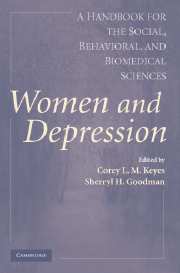Book contents
- Frontmatter
- Contents
- List of Contributors
- Foreword
- Preface
- PART I NOSOLOGY, MEASUREMENT, AND THE EPIDEMIOLOGY OF WOMEN AND DEPRESSION
- PART II BIOLOGICAL, DEVELOPMENTAL, AND AGING MODELS OF RISK
- PART III COGNITIVE, EMOTIONAL, AND INTERPERSONAL MODELS OF RISK
- PART IV SOCIAL, POLITICAL, AND ECONOMIC MODELS OF RISK
- 12 Social Suffering, Gender, and Women's Depression
- 13 Women, Work, and Depression
- 14 Culture, Race/Ethnicity, and Depression
- 15 Trauma and Depression
- 16 Public Health Approach to Depression and Women
- PART V SYSTEMS AND PROCESSES OF TREATMENT, PREVENTION, AND POLICY
- Author Index
- Subject Index
- References
14 - Culture, Race/Ethnicity, and Depression
Published online by Cambridge University Press: 05 June 2012
- Frontmatter
- Contents
- List of Contributors
- Foreword
- Preface
- PART I NOSOLOGY, MEASUREMENT, AND THE EPIDEMIOLOGY OF WOMEN AND DEPRESSION
- PART II BIOLOGICAL, DEVELOPMENTAL, AND AGING MODELS OF RISK
- PART III COGNITIVE, EMOTIONAL, AND INTERPERSONAL MODELS OF RISK
- PART IV SOCIAL, POLITICAL, AND ECONOMIC MODELS OF RISK
- 12 Social Suffering, Gender, and Women's Depression
- 13 Women, Work, and Depression
- 14 Culture, Race/Ethnicity, and Depression
- 15 Trauma and Depression
- 16 Public Health Approach to Depression and Women
- PART V SYSTEMS AND PROCESSES OF TREATMENT, PREVENTION, AND POLICY
- Author Index
- Subject Index
- References
Summary
INTRODUCTION
Mental health problems affect approximately 26% of U.S. adults in a given year and 50% at some point in their life time (Demyttenaere et al., 2004; U.S. Department of Health and Human Services [DHHS], 1999). The leading causes of disability in the United States, in fact, include four mental health conditions: major depression, bipolar disorder, schizophrenia, and obsessive-compulsive disorder (OCD; Murray & Lopez, 1996). Depressive disorders, however, are more common than schizophrenia and OCD's. For example, in the Epidemiological Catchment Area (ECA) study, about 9.5% of adults over the age of 18 were diagnosed with a depressive disorder in a given year compared to 1.1% for schizophrenia and 2.3% for OCD (Regier et al., 1993). It is estimated that 16% of American adults meet criteria for major depressive disorder at some time in their life (Kessler et al., 2003) and the prevalence of depressive disorders is markedly increasing in younger cohorts compared to older ones (Kasen, Cohen, Chen, & Castille, 2003).
However, racial differences in the risk of depression is unclear. African Americans appear to have equivalent or lower rates of major depression than Whites (Kessler, McGonagle, Schwartz, Glazer, & Nelson, 1993; Kessler et al., 2003; Robins & Regier, 1991) but higher rates than Whites of depressive symptoms (Vega & Rumbaut, 1991; Williams & Harris-Reid, 1999). The limited available data for other racial groups suggest that the prevalence of mental health problems is similar to those of Whites but the need for more research on this topic has been explicitly stated by a growing contingent of mental health scholars (U.S. DHHS, 2001).
- Type
- Chapter
- Information
- Women and DepressionA Handbook for the Social, Behavioral, and Biomedical Sciences, pp. 328 - 359Publisher: Cambridge University PressPrint publication year: 2006
References
- 12
- Cited by



